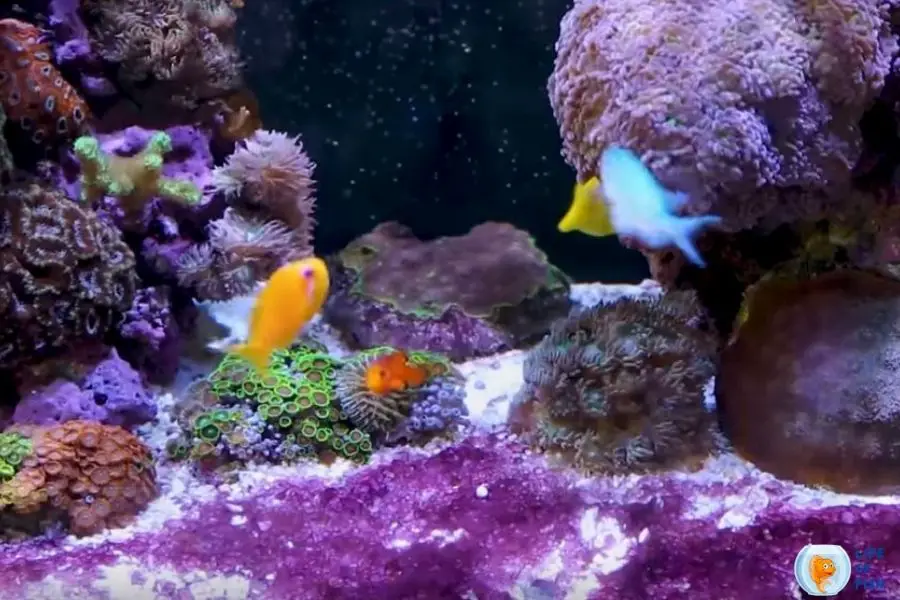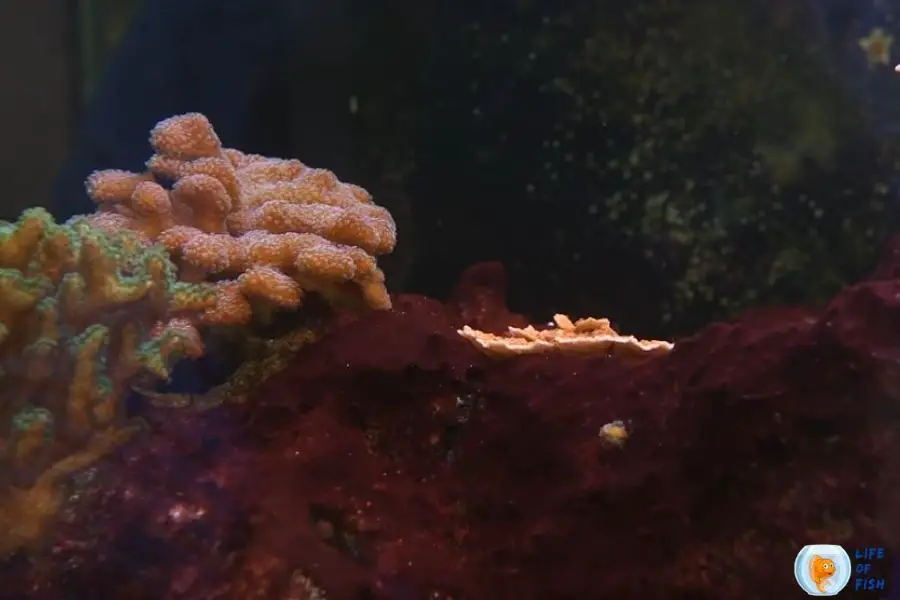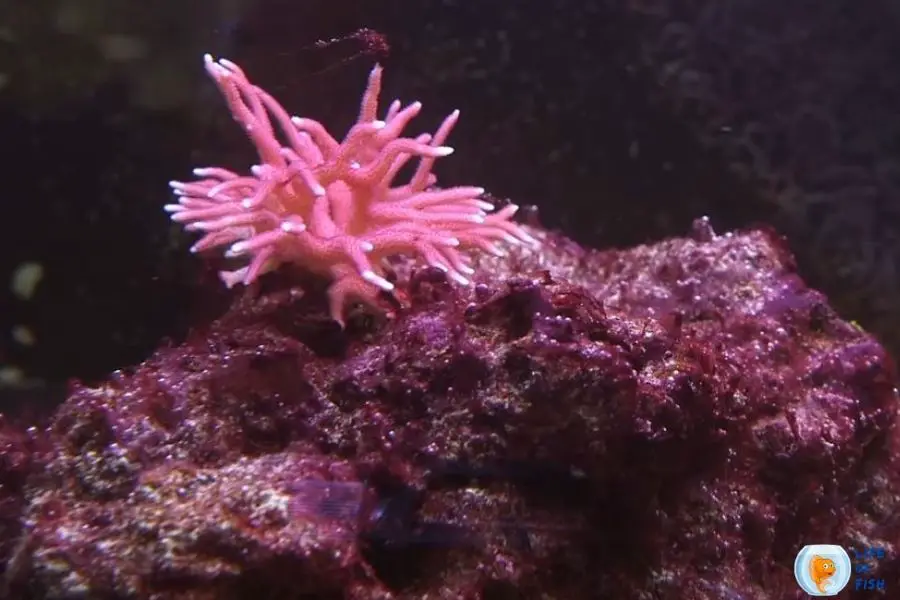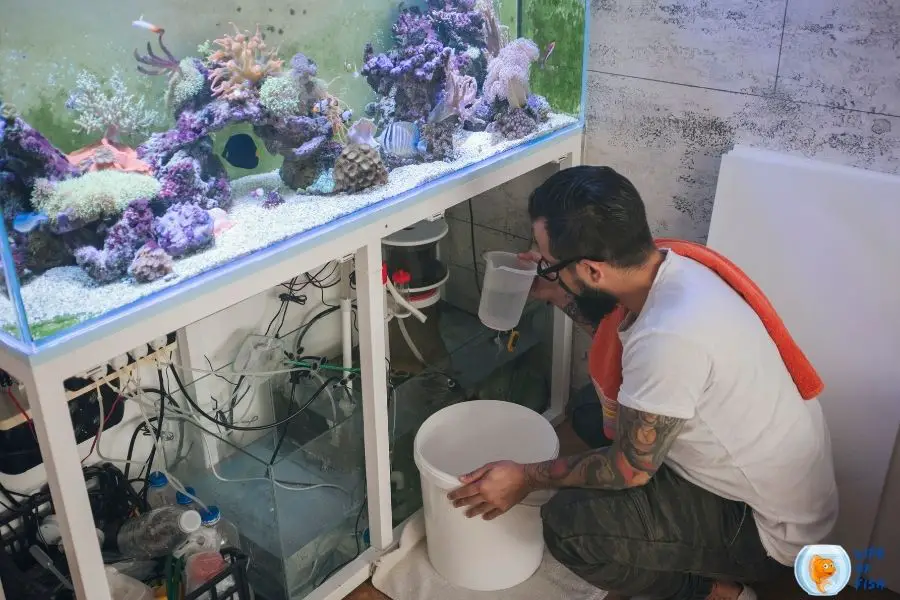A clean and attractive reef tank is a kind of challenge to any aquarist. In this challenge, cyanobacteria in a reef tank is a difficult problem to win. However, do not panic. This article will properly guide you to break this barrier.

What Are Cyanobacteria?
Jump To
- 1 What Are Cyanobacteria?
- 2 How Do I Get Rid Of Cyanobacteria In a Reef Tank?
- 3 How To Identify Cyanobacteria In a Reef Tank?
- 4 What Causes Cyanobacteria in a Reef Tank?
- 5 Do any fish eat cyanobacteria?
- 6 Will Cerith Snails Eat Cyanobacteria?
- 7 Will Nassarius snails eat cyanobacteria?
- 8 What Eats Cyanobacteria In The Ocean?
- 9 Why Does Cyanobacteria grow In New Reef Tank?
- 10 Brown Cyanobacteria In a Reef Tank
- 11 What Eats Cyanobacteria In The Wild?
- 12 Conclusion
Cyanobacteria is one of the oldest lifeforms on the earth. It is a common Photosynthetic organism. Also, they are known as cyano or red slime algae. You can distinguish cyanobacteria easily by their colors. Furthermore, cyanobacteria do not come with only reddish-purple. Some cyanobacteria are green and bluish-green in color. Also, bright red, orange, brown, purple, and black cyano are common.
Further, cyanobacteria look like algae. So, they are often mistaken for algae. But they are bacteria, not algae. Especially, they have inherited the properties from both bacteria and algae. Moreover, you cannot see cyanobacteria individually because an individual cyano has one cell. But they do not like to live alone. Thus, they always stick with other cyanobacteria. Also, in the reef aquarium, cyanobacteria live as a colony.
How Do I Get Rid Of Cyanobacteria In a Reef Tank?
You can eliminate the cyanobacteria in your reef aquarium by the below methods.
Physical removal for Cyanobacteria In a Reef Tank
You can mechanically remove the cyanobacteria from the tank. To be the owner of a nice-looking reef aquarium, you should go through these steps.
Step 1: First, you can refill your water with reverse-osmosis/ deionization (RO/DI) water. Because there are dissolved nutrients such as phosphate and nitrate in non-purified tap water. So, install a RO/DI filter system to discard these nutrients. As a result of this, you can eliminate the active blooms and future blooms.
Step2: Next, you can remove cyanobacteria by scrapping. It would be best if you can scrape the rocks well. Simply, a toothbrush is the best matching tool for it. Then vacuum the substrate of the aquarium. Here, you can use a siphon tube to vacuum sand and rocks.
Step3: Increase the water changing frequency. You can perform water changing at least once a week. At this step, the overgrowth of cyanobacteria is most probably rid. Also, these steps cause to eliminate elevated wastes. Further, it reduces the nutrients that support the growth of cyanobacteria in the tank.
Chemical treatment Cyanobacteria In a Reef Tank
The chemical treatment also kills the cyanobacteria in your reef aquarium. Further, it would be best if you can do chemical treatments with proper care. Also, after doing this treatment, you must closely monitor the ammonia and nitrate levels in the tank water. There are excellent chemical solutions to get rid of cyanobacteria. For instance, Boyd Chemiclean, Blue Life Red Cyano, and Ultralife Red Slime Remover are some of them.
Also, these are reef-safe. When you use these, you should follow instructions properly. Moreover, when you use chemical solutions like Boyd Chemiclean, you must turn off UV Sterilizer or Ozonizer. And also, you should turn off the protein skimmer. Consequently, these actions help to optimize the results of the chemical solutions.
Special Note: However, after cleaning the tank, you must take action to prevent cyanobacteria. So, you should perform a regular water change. It is better to perform small water changes every week or two. Further, try to feed your fish an adequate amount. Furthermore, place your tank where have no direct sunlight. Because direct sunlight motivates the growth of cyanobacteria and algae. At last, maintain your aquarium correctly.
How To Identify Cyanobacteria In a Reef Tank?
You can identify cyanobacteria easily by color. They come in a few colors: green, bluish-green, deep and bright red, orange, brown, purple, and black. Initially, cyanobacteria grow on the rocks and sand bed. Its looks like thin patches. Then, these patches become thick and grow fast. Also, cyanobacteria can cover everything in your reef tank.

What Causes Cyanobacteria in a Reef Tank?
Numerous aspects encourage cyanobacterial growth in your reef tank. Among them, the major causes are listed below.
Decreases the air bubbles
If air bubbles are not enough, it encourages bacteria growth. This happened as a result of the inefficiency of the protein skimmer. Hence, check your protein skimmer efficiently.
Too much reef food.
Uneaten and excess foods generate the byproducts like nitrates and phosphates. These chemicals motivate cyanobacteria growth. So, you should avoid overfeeding in your reef tank.
Skipping the water changes
Bad water quality directly affects cyanobacteria growth. The water changes reduce the nutrient load in the tank. Also, bacteria are unable to grow successfully in clean water. Also, it helps to keep your tank clean.
An inadequate flow rate
It also supports the growth of cyanobacteria colonies. You can use a powerhead and optimum flow rate to eliminate this issue.
Immature live rocks
Immature live rocks act as a breeding ground for cyanobacteria. Thus, they motivate the cyano growth in your reef tank.
Bad lighting conditions and stagnant water
These aspects also encourage cyanobacteria growth. Further, RODI water with more than 0 TDS and tap water will give the same results. So, you should check the TDS meter on the RODI unit.
Low pH and low oxygen level
Acidic and anaerobic conditions increase cyanobacteria growth.
Lower-quality salt, old live rocks, and long photoperiods
Further, you should be highly concerned about the above factors. Because they may encourage cyanobacteria growth in your reef tank. Also, most of these causes are easy to remedy. The secret is proper care and maintenance.
Do any fish eat cyanobacteria?
Court jester goby or Rainford’s goby is an attractive little fish. They have green and orange stripes with black and white spots. Generally, they pick cyanobacteria. Hence, the court jester helped to remove cyano from reef aquariums. Also, they are fairly social. Thus, suitable for Nano or large-scale marine tanks.
Will Cerith Snails Eat Cyanobacteria?
Yes, Cerith snail eats cyanobacteria in your reef tank. They feed not only cyanobacteria but also diatoms, film algae, hair algae, and detritus. Cerith snail is a great member of your reef clean-up crew. Moreover, Cerith snails are mostly active at night time. Another noteworthy thing is, that this snail is reef safe. Additionally, this snail can put itself right after falling from the rocks or glass. However, this ability is rarely seen among other marine snail varieties.

Will Nassarius snails eat cyanobacteria?
No, Nassarius snails do not eat cyanobacteria. They are carnivorous snails. Thus, they do not clean the sand from algae. But, this snail type support to prevent the cyanobacteria indirectly. They eat the remaining fish food particles. It helps to keep the sand clean. Also, it will reduce the nitrate and phosphate levels in the water. Hence, the Nassarius snail is an excellent creature for your reef aquarium collection.
What Eats Cyanobacteria In The Ocean?
There is a wide range of animals that eat cyanobacteria in the ocean. However, among them, the sea slug is the most popular animal. Especially sea slugs can eat cyanobacteria. Here, I mentioned some of them.
Hairy sea hare
The hairy sea hare is one of the snail varieties that eat cyanobacteria in the ocean. Similarly, they are known using their scientific name: Bursatella leachii. Further, they belong to the family Aplysiidae. They can grow about 6-12 cm in size. Also, hairy sea hares have brown color long bodies. Generally, you can see them in Indo-Pacific, Mediterranean and Caribbean waters.
Long-tailed hairy sea hare
Another sea slug is Long-tailed hairy sea hares. Their scientific name is Styloceilus sp. Again, this slug also belongs to the family Aplysiidae. When considering their body size, they can reach up to 5-8 cm. Similarly, Long-tailed hairy sea hares also have long bodies. Further, long-tailed hairy snails have long tails. That’s why they got this name. In addition to that, their body covers with tiny spiky projections. Because of these projections, they look furry. Further, the long-tailed hairy sea hare has a black or brown color body with bright blue or purple spots.
Banded Trochus Snails
This reef-safe snail also consumes cyanobacteria from rocks, substrate, and aquarium walls. Further, their scientific name is Trochus sp.
Dwarf blue leg hermit crabs
In addition to these slags, Dwarf blue leg hermit crabs also eat cyanobacteria. Their scientific name is Clibanarius sp. This small creature can grow up to 1 inch in size.
Electric blue hermit crab
This crab also feeds on red slime algae or cyanobacteria. Scientifically, they are known as Calcinus elegans. Further, they have unique bright orange antennae. Additionally, bright blue legs with black banding give a unique appearance to them.
Halloween hermit crab
Furthermore, the Halloween hermit crab also eats cyanobacteria in the ocean. Also, they are scientifically referred to as Ciliopagurus strigatus.
Why Does Cyanobacteria grow In New Reef Tank?
There are several reasons to grow cyanobacteria in a reef tank. The first one is overfeeding. Whether your reef tank is new or old overfeeding encourages cyanobacteria to grow. Because uneaten food particles tend to produce phosphate and nitrate. Poor water conditions also support the growth of cyanobacteria. If your tank has no protein skimmer, it causes to grow cyanobacteria.
Generally, reef tanks require proper lighting conditions. Hence, bad or improper lighting conditions will lead to the growth of cyanobacteria. So, when you set the aquarium lights in your new reef tank, you should be concerned about this. Most aquarist use tap water for their reef tanks. It can be a major reason to grow bacteria. Because, if you add non-purified tap water, it can increase nitrates and phosphate levels. So, it will lead to cyanobacteria growth.

Brown Cyanobacteria In a Reef Tank
Typically, blue-green cyanobacteria are familiar. But you can see cyanobacteria in other colors. So, brown color cyanobacteria are also present in reef tanks. Further, these brown color colonies can be seen as a brown carpet in your reef tank.
What Eats Cyanobacteria In The Wild?
There is a natural force to battle cyanobacteria in the wild. So, they will fairly balance the growth of the cyanobacteria. For instance, there are some members of the natural force.
- Hairy sea hare
- Long-tailed hairy sea hare
- Cerith snail
- Trocus
- Banded Trochus Snails
- Dwarf blue leg hermit crabs
- Electric blue hermit crab
- Halloween hermit crab
Conclusion
Cyanobacteria is a primitive organism that originated thousands of years ago. Further, they will distribute various ecosystems on the earth. In the aquarium, these bacteria are not an expected thing. Because they reduce the attractiveness of the tank. This article clearly suggests different methods to eliminate and prevent cyanobacteria from a reef tank.
Read Next : Why Are Female Betta Eggs Sticking Out? And How to Treat
